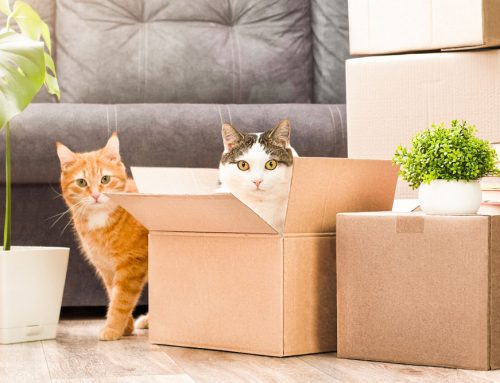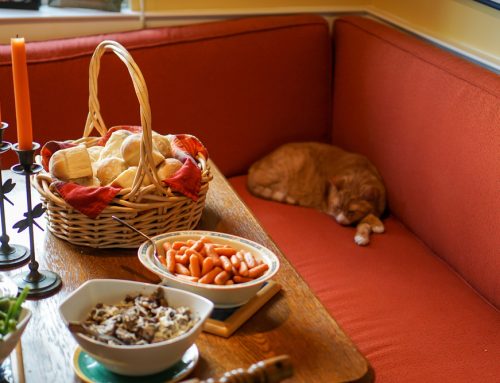There’s no better teacher than past mistakes, but your veterinary team does not want your furry pal to learn from their own mistakes about holiday safety. To help illustrate the many holiday hazards and how to prevent them in your own pet, two fictional pets share their stories. Read on to learn the pet holiday safety tips shared by Holly the miniature schnauzer and Mistletoes the six-toed cat.
Beware of hazardous foods for pets
Holly the miniature schnauzer was always on the lookout for extra snacks, because she was on a strict diet to avoid weight gain and gastrointestinal (GI) issues. While her owner was distracted whipping up a holiday feast for 20 of their closest friends and family, Holly grabbed her opportunity to scrounge through the trash for tidbits and quickly enjoyed a feast of ham from a discarded bone and drippings on foil.
Holly’s dumpster-diving escapade landed her in Cedar Creek Pet Hospital with a nasty bout of pancreatitis. Thankfully, she had only nibbled around the bone, as she would have likely needed emergency surgery to remove any bone she ingested. However, the high level of fat in the ham and grease overwhelmed her pancreas. As a miniature schnauzer, Holly was already predisposed to pancreatitis, and fatty foods can cause a potentially fatal pancreatic inflammation episode. Fortunately, Holly pulled through with intensive nursing care, and left the hospital with strict instructions on preventing a future flare-up.
Holly’s tips: Holly learned her lesson about digging through the trash. To help prevent other pets from making the same food-related mistakes, Holly recommends avoiding the following dangerous foods:
- Turkey skin, bones, and dark meat
- Ham and other fatty meats
- Garlic, onions, chives, and scallions found in casseroles and stuffing
- Butter, cream, and other rich dairy products
- Nuts, especially macadamia nuts
- Alcohol
- Chocolate
- Xylitol
Safeguard your Christmas tree against your pet
Mistletoes loved nothing more than climbing up high and hiding in lofty places, so the Christmas tree was especially appealing. When the tree went up, so did Mistletoes. He leaped onto the uppermost tree branches and—down went the tree, and down went Mistletoes. Fortunately, the tree was not decorated with delicate ornaments, but Mistletoes still had quite the fright as the tree came crashing down.
Mistletoes’ family tried again and erected a barrier around the tree, hoping to prevent their frisky feline from scaling their fir. Mistletoes was more cautious with his second approach and waited until the family went to bed before investigating the now glittering and twinkling tree.
Mistletoes easily jumped the barrier, climbed the tree, and found a wondrous dangling strand of sparkly tinsel. Intrigued with the shiny thread, he nibbled and gnawed until he ingested a sizable length.
The next day, Mistletoes was not his normal feisty self. He was lethargic and then began vomiting, so his concerned family took him to see Dr. Peterson, who performed a physical exam, conducted diagnostic tests, and determined that Mistletoes had a linear foreign body (i.e., a string-like object stuck in his gastrointestinal [GI] tract).
The veterinary team stabilized Mistletoes and headed to surgery to remove the offending object. Despite being covered in GI juices, the tinsel twinkled through. The naughty cat was sent home in a cone of shame and told to leave the tree and all decorations alone.
Mistletoes’ tips: Mistletoes learned that, although the tree was an especially attractive climbing post, pets should stay away from this decorative danger. He advises pet owners to protect their pets by watching out for the following tree-related hazards:
- Tree stand water — A full bowl may trick your pet into thinking that the water is for them, but tree stand water can contain chemicals and bacteria, and is toxic to cats and dogs.
- Electrical cords — Electrical cords crisscrossing the tree and your floor may entice your furry pal to take a nibble, only to receive a shocking surprise. Ensure your pet cannot reach any cords by placing them strategically, using cord covers, or barricading your tree behind impenetrable defenses.
- Ornaments — Glass, ceramic, or salt dough ornaments hung with metal hooks pose multiple threats to your pet. Opt for unbreakable ornaments, and avoid sharp metal hooks.
Guide guests on appropriate pet interactions

Shrieking children rushed into the house and made a beeline for the cat and dog curiously watching the commotion. The pets immediately fled the scene and looked for cover, but the children chased them relentlessly until they were cornered. The pets put up with as much “affection” as they could take, and then began growling and hissing, clearly asking to be left alone. At this point, the adults caught up and removed the pint-sized pests, leaving the pets in peace.
Holly and Mistletoes’ tips: Although Holly and Mistletoes disappeared for the rest of the holiday celebrations, we devised our own safety tips from their actions.
All too often, guests—particularly children—force interactions with pets. In many cases, cats and dogs are wary of strangers, especially when their house is full of noisy, unfamiliar people. Protect your pets from your guests and vice versa by instructing visitors to leave pets alone unless they approach first.
Ideally, ensure your pet has a safe space to ride out the festivities, whether they include rambunctious party games or an earsplitting countdown to midnight. The safe spot will also keep your pet out of guests’ rooms, where suitcases may be left open or purses left on the floor, exposing your pet to medication, toiletries, gum, or chocolate.
Heed the wise words of Holly and Mistletoes to keep your furry pal out of trouble this holiday season. However, accidents can still happen. If your pet finds themselves tangled in tinsel or covered in turkey drippings, contact our Cedar Creek Pet Hospital team for help and let us take care of their holiday mishap.






Leave A Comment